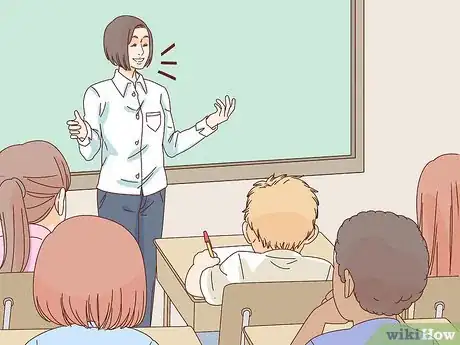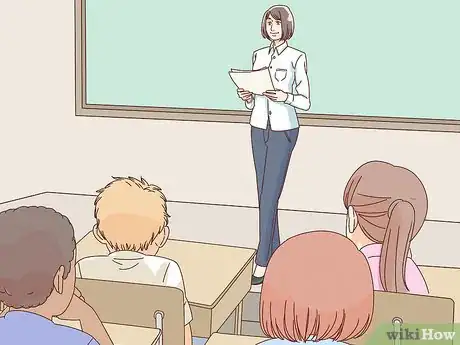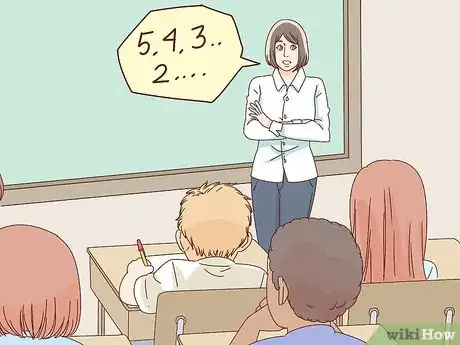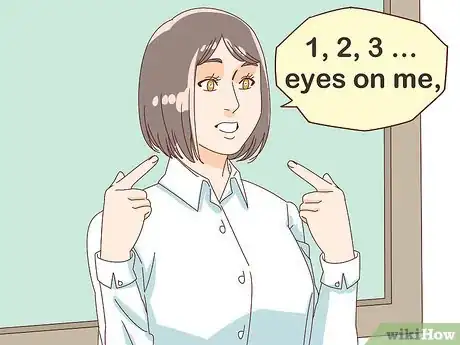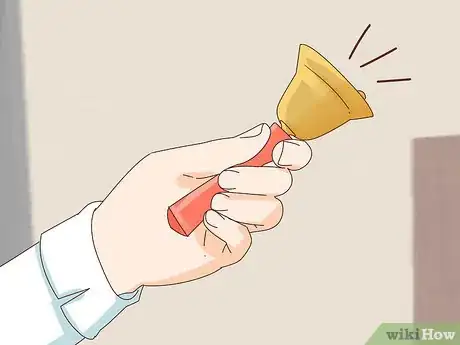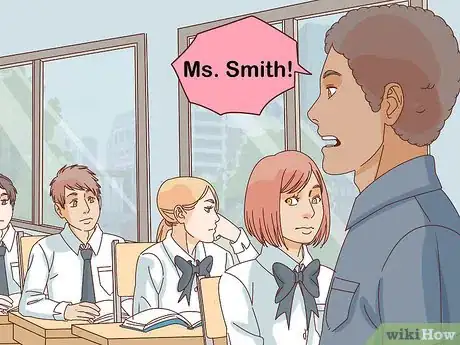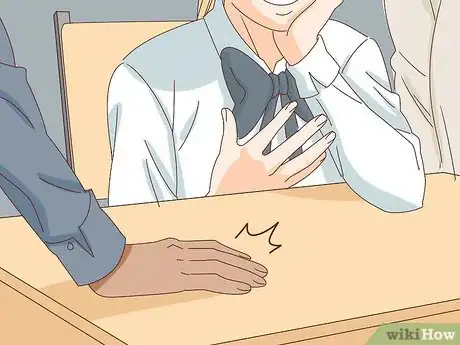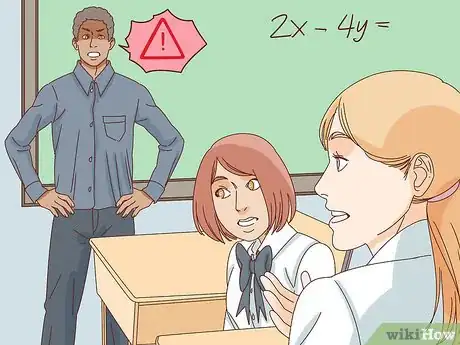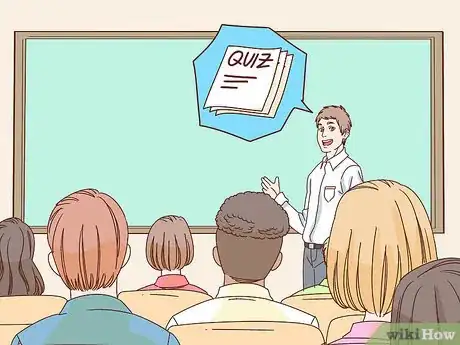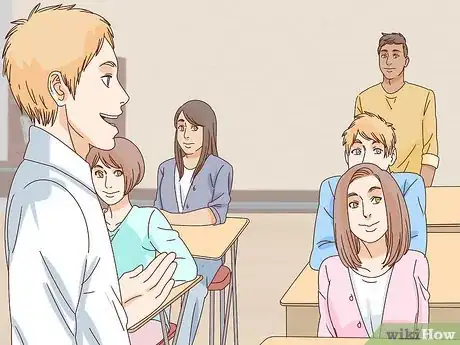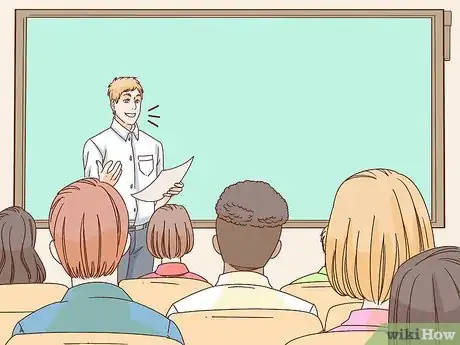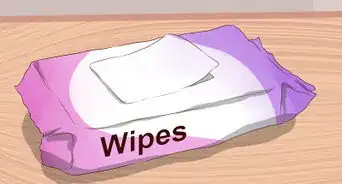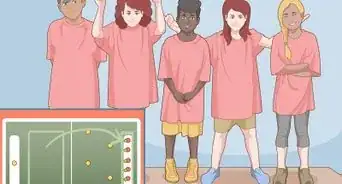This article was co-authored by Soren Rosier, PhD and by wikiHow staff writer, Hunter Rising. Soren Rosier is a PhD candidate at Stanford's Graduate School of Education. He studies how children teach each other and how to train effective peer teachers. Before beginning his PhD, he was a middle school teacher in Oakland, California, and a researcher at SRI International. He received his undergraduate degree from Harvard University in 2010.
This article has been viewed 156,971 times.
Getting the attention of an entire class can be a challenge no matter what age group you’re teaching. While it can feel intimidating, there are strategies you can use so your class is ready to learn. If there’s an individual student that still isn’t paying attention, you can address them one on one. Once you have your class’s attention, keep your lesson engaging and exciting so they stay focused!
Steps
Calming an Entire Class
-
1Change the tone of your voice to signal class is about to begin. Go the front of the room to tell your class you’re about to get started. Raise the volume of your voice and speak in a firm tone to get your student’s attention. Try to talk over your students without shouting or yelling so they can hear you easily.[1]
- You can use this no matter what age you’re teaching.
-
2Try standing in front of class quietly and waiting for them. Choose a designated spot near the front of the room and stand there when you want your class to pay attention. At the start of class or whenever you’re teaching a lesson, go the spot and wait quietly. Look at the direction of the people who still aren’t paying attention to you so they understand that they’re holding up the rest of the class.[2]
- Show your students the spot where you’ll stand on the first day of class so they know what to expect.
- This may work best with students who are in high school or college.
Advertisement -
3Count backward from 5 so your class knows when to pay attention. Let the class know you’re going to count down and that it needs to be quiet by the time you reach 0. Stand where everyone can see you and start counting down from 5 out loud. Hold up the same number of fingers while you’re counting so students can see the countdown. Make sure all your students give you their full attention when you’re finished.[3]
- Use counting with elementary or middle school students.
- Speed up or slow down the countdown to adjust to your students. For example, you may count slower for younger kids and faster for older students.
-
4Use a call and response so your students need to listen to you. Come up with a phrase or signal that you can say when you want your students to listen to you. Give your students a phrase or signal that they should do when they’re listening. Repeat the call and response as many times as you need until all your students are paying attention.[4]
- This works best for elementary school students.
- For example, you may say something like, “1, 2, 3, eyes on me,” and your students would respond, “1, 2, eyes on you.”
- You can also clap once and tell your students to clap twice in response.
-
5Play a sound cue to let the students know your class is starting. Pick a sound that will stand out against your students if they’re talking. Use a bell, chime, or whistle to help get your students’ attention. If your students still aren’t focusing or quieting down, play the sound again to see if they settle down.[5]
- You can use this for any grade you teach.
- Give your class a warning if you need to play the sound too many times. You may tell them if you ring the bell 3 times, then there will be some form of consequence.
Tip: Play fun or relaxing music at the start of class to get everyone in a good mood so they’re ready to learn.
Addressing a Single Student
-
1Talk directly to the student if they aren’t paying attention. Stand in a place where the student can clearly see you. Say their name out loud in a firm tone of voice so they know it’s time to focus. Look them in the eye so they settle down and pay attention to you in class. If they still don’t notice you, say their name again slightly louder and ask them to please pay attention.[6]
- Never shout at a student if they aren’t paying attention to you.
-
2Tap their desk to let them know it’s time to focus. Approach the student’s desk while they’re talking and tap their desk your hand. You can also move a piece of paper or pencil so can get their attention. When they see you next to them, they’ll know that they need to be quiet so you can continue with the class. If they keep talking, say their name and ask them to be quiet.[7]
- Don’t touch the student directly when you want to get their attention since it may not be appropriate to.
-
3Give the student a warning before removing participation points. Pull the student that’s not paying attention aside and give them a verbal warning to let them know they’re interrupting the class. Let them know that it could affect points for class participation unless they pay attention. Give them a few seconds to settle down before starting or continuing your lesson.[8]
- This works best for high school level students.
Tip: If the student is being rude and still doesn’t settle down, you may need to write them up or send them to the office.
Maintaining Their Attention
-
1Plan a quiz or activity after your lesson so your students need to pay attention. Schedule an activity that’s using information from the lesson you’re teaching. Tell your students at the start of your lesson that there’s an activity or quiz at the end of class so they should pay attention to do well. Give the instructions for the activity at the end of your lesson so your class can complete it.[9]
- For example, if you’re teaching a new math concept or formula, you may hand out a worksheet or create sample problems for the class to solve at the board.
-
2Ask discussion questions while you’re teaching your lesson. Throughout your lesson, ask open-ended questions about the subjects your teaching. If no one answers your questions, call on a student to get their thoughts on the subject. Invite your students to ask questions and talk as a group about the answers. This can help students learn communication and listening skills.[10]
- For example, if you’re teaching a history lesson, you may ask your class how what they’re learning about relates to current events.
- Reward class participation with a small treat or points to make learning more into a game.
Warning: Make sure your discussions don’t divert too far from the topic you’re teaching. Get your class’s attention again if you spend too much time on other subjects.
-
3Change the tone of your voice while presenting to make it sound interesting. As you go through your lesson, adjust the speed and pitch of your voice so what you’re teaching sounds engaging to your students. Sound excited about the topic you’re teaching since it can help motivate students to pay attention and learn more.[11]
- Try changing the volume of your voice as well since students will have to be quiet and focus more if you speak quietly.
- Add some humor into your lesson to make your students laugh and make them more engaged in what you’re teaching.
Expert Q&A
Did you know you can get expert answers for this article?
Unlock expert answers by supporting wikiHow
-
QuestionHow can I get my students to be quiet?
 Soren Rosier, PhDSoren Rosier is a PhD candidate at Stanford's Graduate School of Education. He studies how children teach each other and how to train effective peer teachers. Before beginning his PhD, he was a middle school teacher in Oakland, California, and a researcher at SRI International. He received his undergraduate degree from Harvard University in 2010.
Soren Rosier, PhDSoren Rosier is a PhD candidate at Stanford's Graduate School of Education. He studies how children teach each other and how to train effective peer teachers. Before beginning his PhD, he was a middle school teacher in Oakland, California, and a researcher at SRI International. He received his undergraduate degree from Harvard University in 2010.
PhD in Education Candidate, Stanford University
Warnings
- Avoid yelling or getting angry with your students if they don’t pay attention.⧼thumbs_response⧽
References
- ↑ https://busyteacher.org/6047-15-tricks-get-your-class-attention-hold-it.html
- ↑ https://www.teachthought.com/pedagogy/20-ways-quiet-noisy-students/
- ↑ https://www.teachthought.com/pedagogy/20-ways-quiet-noisy-students/
- ↑ https://www.edutopia.org/blog/30-techniques-quiet-noisy-class-todd-finley
- ↑ https://busyteacher.org/6047-15-tricks-get-your-class-attention-hold-it.html
- ↑ https://busyteacher.org/6047-15-tricks-get-your-class-attention-hold-it.html
- ↑ https://www.teachthought.com/pedagogy/20-ways-quiet-noisy-students/
- ↑ https://youtu.be/4mLL2HhTE0M?t=60
- ↑ https://teach.com/blog/classroom-management/
- ↑ https://teach.com/blog/classroom-management/
- ↑ https://busyteacher.org/6047-15-tricks-get-your-class-attention-hold-it.html
- ↑ Soren Rosier, PhD. PhD in Education Candidate, Stanford University. Expert Interview. 1 May 2019.
